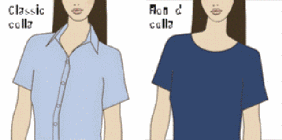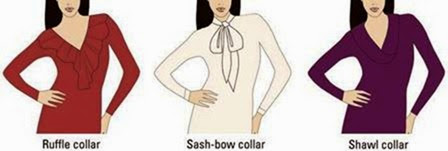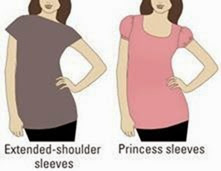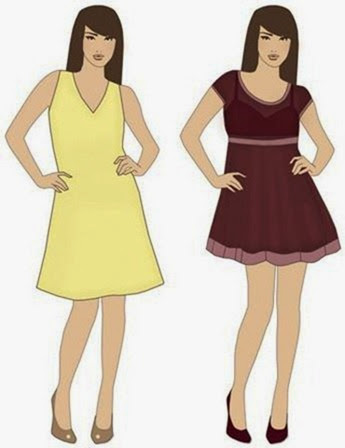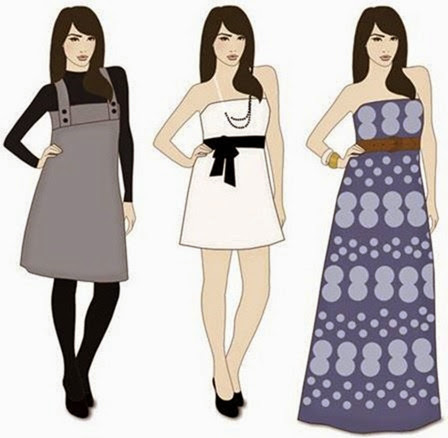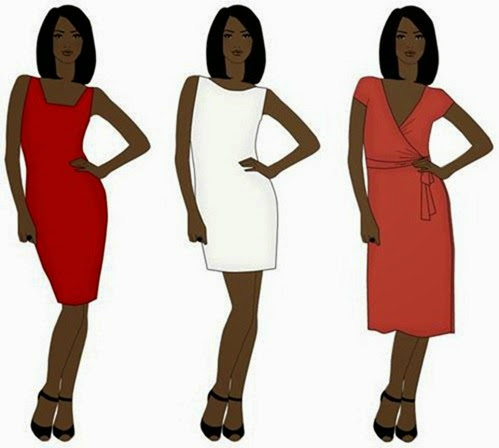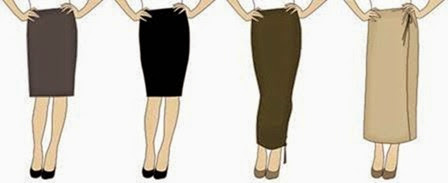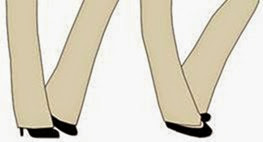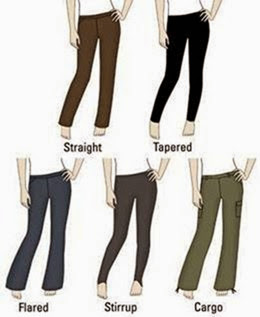Dressing for Every Day
In This Chapter
▶ Knowing what to look for in blouses and sweaters
▶ Understanding skirt and dress styles
▶ Finding the perfect pants
Do you wake up in the morning, open your closet, and pull out the same pair of pants or skirt every time? My guess is you do. Well, that’s okay.
We all have pieces in our wardrobe that we just can’t live without. And, for the most part, it’s fine to wear those pieces over and over again, provided that they are 10s and as long as you mix and match them with a variety of different tops.
Before the late 1800s, women always wore dresses. Obviously, that’s not the case today. Women nowadays have an overwhelming variety of clothing and styles to choose from: pants, dresses, blouses, skirts, and more. The key to being stylish is to make sure that each piece you put on works with your shape and the items you pair with it. This chapter lists the basic wardrobe pieces and explains how you can use them to express your style while remaining true to your personality and body type.
Tops First: Blouses and Sweaters
The right sweater worn with jeans can make for a very sexy outfit. So what’s the “right” sweater? Depends on your body type. Different materials and cuts work better on certain body types. If you’re larger on top, you can project a slimmer appearance by wearing a more fitted, longer sweater (bulky sweaters just make you appear larger). The same holds true for blouses: Just because you love a blouse you see in a store window doesn’t mean that that blouse is the one for you. A beautiful blouse with ruffles draws attention to your upper half. If you’re an apple shape, you’d do better with something simpler on top so as not to draw too much attention to an area you’d rather minimize. If you’re a pear shape, a ruffled blouse accentuates your top half and draws attention away from your hips, which is the goal. The following sections explain what to look for to make sure your tops look and feel great on you.
A fitting start: Getting a good fit
You face a lot of choices when you go to buy a blouse — fabric, color, and pattern — but the number one reason to buy, or not buy, a blouse is fit.
No matter how great the blouse looks on the rack, if it doesn’t fit your body, then it won’t look good on you.
How can you tell whether a blouse fits or not? Here are some guidelines:
The blouse is too big if
✓ You can grab handfuls of fabric.
✓ The neckline won’t lie flat on your neck.
✓ The shoulders drop, causing the neckline to ride up.
✓ The sleeves are too long.
The blouse is too small if
✓ The button line pulls, especially across the chest area.
✓ It feels tight when you cross your arms.
✓ The sleeves are too short.
✓ You can’t roll up the sleeves because it’s too tight on your arms.
A shirt that fits nicely feels comfortable and allows you to move without making it look like you have no shape. In other words, it should make you look and feel like a 10 (refer to Chapter 2 for my 10 System)!
Buttons to the left or right?
You may have noticed that the construction of a woman’s blouse is different than a man’s shirt. The most interesting difference is the location of the buttons: On a woman’s blouse, the but- tons are on the left side; on a man’s shirt, they’re on the right. No one knows exactly when or why this change took place, but one interesting theory is that buttoning a blouse from the left made it easier for ladies’ maids, who were responsible for helping the lady of the house dress, to get the buttons in the buttonholes.
Paying attention to cut
There are two ways to make a blouse or any article of clothing:
✓ Draping: You drape the cloth over a model, work to get the right fit, and then make a pattern from that one piece.
✓ Flat cut: You create the pattern first and then fit the pieces together.
It takes a lot more effort to design with draping, plus there’s the added cost of the models, who can earn as much as $200 an hour. For that reason, blouses (and other articles of clothing) that have been draped are more expensive than those that have been flat cut. You can often tell whether a blouse was draped just by looking at it. If all the angles seem rounded, like at the shoulders, then it was draped. If it appears flatter, then it was flat cut.
In better quality blouses, you also find different cuts: classic, slim, and skinny. The classic cut is looser than the slim cut. The skinny cut is fairly tight. Which cut you choose depends on your body type, your breast size, and where you plan to wear it. If you’re at work and need to move around, you’re going to want a fit that allows you to move easily, such as the classic cut; if you’re going out and want to appear a little sexy, then you may choose the slim or skinny cut.
Higher-end brands, like Ralph Lauren, designate their blouses as slim cut, classic cut, and so on. But not all manufacturers define the cut of their blouses. And not all manufacturers make all three cuts. If you try on blouses by several different designers, you can see which designer’s line fits you best. When you find a blouse that fits you perfectly, see whether you’re interested in anything else in that designer’s line. Chances are, the designer’s other items will also fit you well.
Style elements
For an article as basic as a woman’s blouse, an incredible variety exists. Each area of the blouse — the collar, neckline, sleeve, cuff, waist, and length — can have many different iterations. When you combine them, the variety seems endless.
Collar types
Originally collars were a separate item attached to the shirt. Today all collars come pre-attached. Out of the more than 50 different collar types, the follow- ing are the most common:
✓ Conservative collars: The classic and the round collars (shown in Figure 9-1) are the most common and conservative, and they work with all body types. You really can’t go wrong choosing this collar style.
Figure 9-1: Conservative collars.
✓ Feminine collars: The ruffle, sash-bow, and shawl collars are the most girlie and feminine, and because they draw the eye to your neckline, they’re perfect if you want to draw attention to your upper half. Any of these collars, shown in Figure 9-2, are perfect with a pencil skirt to give your look a little flair.
Figure 9-2: Feminine collars.
✓ Youthful collars: The Peter Pan and sailor collars, shown in Figure 9-3, tend to be on the youthful side. You see them mostly in little girls’ clothes. If you want to be taken seriously as an adult with style, I suggest you avoid these collars altogether.
Figure 9-3: Youthful collars.
✓ Other collars: The Mandarin and the Chelsea collars are style statements in and of themselves, but they’re rarely considered high style. The Chelsea is a very old-fashioned look and is rarely, if ever, seen; the mandarin collar looks a bit costumey. These two collars aren’t necessary to have in your wardrobe.
The button-down collar is more of a man’s shirt collar type. For women, stick with the classic collar. Figure 9-4 shows the Mandarin, Chelsea, and button-down collar types.
Figure 9-4: Other types of collars.
Necklines
Not all shirts have a collar, in which case the neckline is what shows. Because some necklines may suit you more than others, they’re an important factor to consider. The following list describes the most common necklines:
✓ Conservative necklines: The boat neck and the jewel neck, shown in Figure 9-5, are more conservative. The boat neck covers you to the neck, but because it opens wider at the shoulders, it makes your shoulders appear broader, which in turn makes your waist look narrower. If you’re on the small side on top, have narrow shoulders, or want to minimize the waist area, this neckline is great for you. The jewel neck is a round, flat neckline that works well when you want to wear a fabulous necklace. The jewel neck works for every body type and won’t draw attention unless, of course, you accessorize.
Figure 9-5: Conservative necklines.
✓ Feminine and flirty necklines: The halter, keyhole, one-shoulder, and off- the-shoulder necklines are the most feminine and flirty. They expose your shoulders (or at least one of them), which is flattering for most women. (Shoulders are sexy, and bare shoulders are appropriate for any age.) The keyhole neckline exposes just a bit of skin, but makes the top fun and interesting. All of these necklines, shown in Figure 9-6, draw atten- tion to your shoulder and neck area, thus minimizing the attention paid to your bottom half.
✓ Necklines that expose your décolletage: The scoop, square, sweetheart,
V-neck, and wrap-over all expose your décolletage. The only difference
is the actual shape of the neckline (as Figure 9-7 shows). If you like this area and want to show it off, these necklines do that. Again, an interest- ing neckline always draw attention to that area and away from your lower half.
Figure 9-7: Necklines that expose your décolletage.
Sleeves
Sleeves have less variety than other parts of a top, but finding the right sleeve is an important factor for many women. Obviously short-sleeves and sleeveless tops, as well as cap sleeves, are going to expose your arms (see Figure 9-8). If you have great arms and want to show them off, any of these lengths are good for you.
Figure 9-8: Sleeves that expose your arms.
Fortunately, if you don’t want to expose your arms, especially your upper arms, you have other options. In addition to long-sleeves, you can try the three-quarter length sleeve, which ends anywhere from just below your elbow to the middle of your lower arm, showing off just the thin part of your arm. They’re a classic, as well as a perfect way to keep cool in the warmer months.
The bell sleeve is another option. This sleeve gets wider and bells out toward your wrist. Just like flared jeans draw attention to your lower leg, this sleeve draws attention to your lower arm. If you’re self-conscious about your upper arms, bell sleeves flatter you and make a style statement at the same time. Figure 9-9 shows the long, three-quarter, and bell sleeves.
Figure 9-9: Sleeves that cover your arms.
The extended-shoulder and princess sleeves (see Figure 9-10) are all about shoulders and femininity. The extended-shoulder is an unstructured look that softens the appearance of broad shoulders (because there’s no definition to where the shoulder ends and the arm begins). The princess sleeve has a puffy shoulder, a style that also softens the appearance of the shoulder area and gives the top some style.
Figure 9-10: Sleeves that soften the appearance of broad shoulders.
Shapes
The manner in which a blouse covers the upper half of your body is deter- mined by its shape. In addition to length, here are some features that can alter the shape of a blouse (see Figure 9-11):
✓ Darts: Darts make a blouse more fitted and structured. If you have a thin midsection and you want to show it off, a darted blouse accentuates this area.
✓ Peasant or camp style with front and back yokes: This shape is a looser, unstructured cut, with more material around the midsection. It’s soft and feminine and hides your midsection because it just drapes around it.
✓ Shirred waist: A shirred waist is gathered at the waist line. This look is great if you have a thin waist and want to draw the attention there.
✓ Straight hem meant not to be tucked in: This shape is cut straight down, so it doesn’t accentuate your waistline, nor does it hug too tightly. If you are larger in the middle, this cut works for you because it doesn’t look too tight but still shows that you have some shape.
Cute as a button
Most blouses have buttons that go all the way down the front or have several in the back near the neck to make the garment easier to put on and take off. Buttons in the front, back, or none at all are style choices you make when buying a top. In addition to providing a utilitarian or
decorative purpose, buttons can clue you in on the quality of the blouse. The opening down the front is called the placket. If the stitching on the placket looks weak, or the stitches are far apart, then the garment is not top quality.
Figure 9-11: A variety of shapes.
Length is another factor that determines shape. If you have a narrow waist, you can show it off by wearing a shorter length blouse. If you prefer to camouflage your waistline in order to appear longer and leaner, then a longer length may be better.
A word about sweaters
Sweaters are tops made from knit material which, when used as a top and not an over-garment to add warmth, are generally tighter fitting and typically don’t have collars. Sweaters that have buttons down the front are called cardigans. Others are pullovers, because you pull them on over your head (duh!), which is possible because their knitted material is more stretchy.
✓ Fitted sweaters: Fitted sweaters are generally on the simpler side and typically worn alone or over a very thin layer. They can be made from everything from cotton to cashmere, and they come with a variety of necklines: round, V-neck, or turtleneck. They’re usually solid in color and are great to wear with jeans, corduroys, slacks, or even with a skirt. You can dress them up or down, depending on what you pair them with. Fitted sweaters show off your torso. If you want to show off your midsection, these sweaters are right for you.
✓ Chunky sweaters: Chunky sweaters tend to be very casual (they’re best paired with jeans or cords) and, for this reason, they aren’t really for work. If you’re on the heavier side, a chunky sweater makes you look even larger. If you’re on the petite side, a chunky sweater can over- whelm you.
✓ Fancy sweaters: If you want to wear a sweater out at night or to someplace dressier, look for one with adornments. Fancy sweaters are especially appropriate and readily available around the holidays. Many sweaters are decorated with sequins, paillettes, or rhinestones, which make them dressier and more appropriate for evening wear.
Sweaters by nature are clingy and show off your curves. If you are at all self- conscious about this, sweaters on their own may not be the right look for you. Try putting a fitted sweater under a blazer or layer a sweater over a blouse so that it doesn’t cling as tightly.
Skirts and Dresses
Nothing is better than wearing a dress to work (or out!) that fits your body perfectly. Some women say that slipping on a dress is easy because there is very little thinking to do; just accessorize and go!
Dress styles
I wear dresses to the beach and to black-tie affairs. Dresses were once considered formal, but now you can pretty much get away with a dress anywhere, anytime. When choosing the right piece to wear, you must ask yourself many different questions regarding length, style, and what you want your overall look to be. You must make many choices before determining the perfect dress for any occasion.
✓ A-line: An A-line dress (see Figure 9-12) is fitted at the waist and flares out from the waist down. This style looks good on everyone. It’s especially good for camouflaging your hips and thighs, so if you’re a pear shape or just want to hide this area, the A-line is the perfect choice.
✓ Babydoll: Short, flouncy, and with an empire waist (see Figure 9-12), a babydoll dress may look more like a negligee than a dress. Even though the neckline is usually more round than plunging, it is sexy. The empire waist on this style camouflages your midsection by loosely draping over that whole area. If you’re trying to cover your tummy, a babydoll dress will work for you. If you’re apple shaped, be careful. The empire waist accentuates your bust and upper body, causing you to look even more top-heavy. This style is best for tall, thin types and tends to look very youthful, so take your age into account if you try to pull this off.
✓ Cocktail dress: The cocktail dress encompasses many styles (including the little black dress) and is appropriate at almost every occasion (see Figure 9-13). You can dress it up or down with the help of accessories. Cocktail dresses are generally around knee length — unless, of course, they’re tea length, which means they end mid-calf. They can be sleeve- less, strapless, or have sleeves long or short. Because there are so many styles, you can easily find one that’s right for your body type.
✓ Empire dress: The waist of this style of dress is set above the natural waistline, often just below the bust (see Figure 9-13). Similar to the babydoll dress, the empire dress can be any length and doesn’t have to be flouncy. This type of waist is good for someone with a smaller bust because it accentuates that area. It also takes your true waistline com- pletely out of the picture. So if you have issues with your tummy, waist, hips, or anywhere below the bust line, this dress hides all that for you.
Figure 9-12: From left: A-line and babydoll.
✓ Evening gown: For formal, black-tie occasions, most evening gowns are floor length (see Figure 9-13). Because they’re not exclusive to one body type, anyone should be able to find an evening gown that flatters her body type. You just need to follow the body type rules and find one
that works for you. Evening gowns can be very simple or have embellishments like lace or beading. It’s really about personal style. My favorite evening gown is strapless, black, and simple.
Figure 9-13: From left: Cocktail, empire, and evening gown.
✓ Jumper: A jumper is a sleeveless dress designed to be worn over a blouse, T-shirt, or sweater (see Figure 9-14). Jumpers can vary in length, but most hit right at the knee, and they’re often paired with pumps or high boots. This cut is pretty straight so anyone can wear it.
✓ Mini: Any dress that stops 2 or more inches above the knees qualifies as a mini, shown in Figure 9-14, though the actual style can vary from a sheath to a shift. Micro-minis are even shorter. The mini is best for someone — apples, this usually means you — with thin legs. Regardless of your shape, if you’ve got great legs, show them off. Keep in mind, though, that the mini is a youthful look.
✓ Maxi: The maxi was a counterpoint to the mini, bringing hemlines down after they’d crept up. A maxi, shown in Figure 9-14, is a full-length dress and works for those who want to cover up their bottom half. It also gives you the appearance of being longer and leaner because of the one, long line of material.
✓ Sheath: A sheath dress, shown in Figure 9-15, is very fitted (so it shows off your curves) but has no waist, thus creating a long line that has a slimming effect. Sheaths are usually sleeveless. If you’d prefer not to expose your arms, this dress style isn’t right for you.
Figure 9-14: From left: Jumper, mini, and maxi.
✓ Shift: A shift is a straight-cut dress with no waist (see Figure 9-15). Shifts are a great choice for those who don’t want something as fitted as a sheath but still want to wear a flattering dress. Again, because the dress has no waist, it creates a long, lean line in the torso; it’s a good style for every body type.
✓ Wrap: A wrap dress, shown in Figure 9-15, wraps around your body and closes in the front. Diane Von Furstenberg made the wrap dress famous back in the 1970s. These dresses are classic and flatter every body type because they accentuate the neckline, and the line where it wraps creates a long appearance. You can also wrap the dress so that it’s just the right fit — not too tight or too loose — which also is more flattering.
Figure 9-15: From left: Sheath, shift, and wrap.
Skirts
The advantage that skirts and blouses have over dresses is that you can mix and match them to get many different looks. Take a bold, fun-patterned skirt, for example, and match it with a plain white T-shirt for a chic look, or pair a beautiful silk blouse with a pencil skirt and be ready to go. It’s all about how you mix and match.
If you’re like most women, you like certain parts of your body more than others. Because women have so many likes and dislikes, designers have created a plethora of skirt styles to fit any body type. The trick is (again) knowing what your best parts are, highlighting them, and choosing with confidence clothing that works best on you. Take skirt length, for example.
If your legs are skinny, you want to wear skirts that have hemlines ending at the widest part of your leg (your thighs) — in other words, miniskirts. This doesn’t mean you can’t wear other types of skirts; instead it means that a mini looks great on you. If, on the other hand, your legs are heavier, your hemline should hit the skinniest part of your leg, which is most likely somewhere below the knee, possibly even below the calf.
In addition to skirt length, you have skirt style to consider. Here are some of the most popular varieties:
✓ A-line: A-line skirts are snug at the waist, barely touch your hips and thighs, and widen as they approach the hem (see Figure 9-16). Usually their length is below the knee. They’re a good look for pear-shaped women who are heavier in the hips and thighs and not flattering to women without much of a derriere. However, a large pattern can make an A-line more suitable for thin women.
✓ Flared: A flared skirt is an A-line with more material so that it swings and swishes about your lower legs as you walk, adding to the slimming effect (see Figure 9-16). A flare with an uneven hem, especially in a light- weight fabric like chiffon, draws the eye away from your hips even more.
✓ Circle or peasant skirt: With lots of material, these skirts hide everything! They’re full length and very loose and drapey, as shown in Figure 9-16, so you really can’t see any shape underneath. So girls, whether you want to appear larger or smaller, this skirt does the trick!
Figure 9-16: From left: A-line, flared, and circle skirts.
✓ Straight skirt: In a straight skirt, the material falls straight from the hip (see Figure 9-17). Larger women should have more length in their straight skirts, while thinner women look better if the skirt is shorter.
If you’re tall, you can pretty much get away with a straight skirt being long or short, but if you’re shorter, showing more leg makes you appear taller. If you want to show off your curves, choose a straight skirt in a material that clings, like satin. Vertical details on the skirt, such as pin- stripes or stitching, can add to the slimming effect.
✓ Pencil skirt: Like the straight skirt, the pencil skirt’s material falls from the hip but is more fitted to the body to emphasize the hips (see Figure 9-17). These skirts aren’t ideal for those who need camouflage. If you have small hips, a high waist makes you appear more curvy. Generally pencil skirts are knee length, but the shorter your torso, the shorter the skirt should be to add length to your legs. Normally pencil skirts are plain and monochromatic.
✓ Tube skirt: The tube skirt is like the pencil skirt but longer, sometimes all the way to the ankle (see Figure 9-17). In fact, the only way you can walk in a tube skirt is if the skirt has a slit. This isn’t an easy look for most women to pull off because it is very fitted and clingy and shows everything on your lower half except for skin. Not to worry though, you don’t see many of these skirts around!
✓ Wrap skirt: A wrap skirt, shown in Figure 9-17, can be long or short. If you get one that’s the right length to flatter your legs, this type of skirt can look good on any body type. Like the wrap dress, you can adjust it to fit you perfectly.
Figure 9-17: From left: Straight, pencil, tube, and wrap skirts.
Slacks
Many women think skirts are sexier than pants. Are they? The answer is, not always. Although a great pencil skirt can show off your curves and give you a sophisticated, classic look, the right pair of slacks can do the same thing. Find out how to choose your pants wisely in this section.
Length
The most distinguishing aspect of slacks, besides the material (discussed in the later section “Pant material”), is length. Women have the choice between pants that are full length, ankle length, or capri style, which can reach anywhere from the calf almost all the way to the knee, where they actually infringe on the territory claimed by shorts.
Pant length is measured not from the top of the waist, but from the bottom of the crotch to the bottom of the pants leg. This measurement is called your inseam. It’s hard to measure your inseam yourself, but if you get help and keep it noted somewhere, it can be a very helpful measurement to know when buying slacks. (For information on other key measurements, refer to Chapter 3.)
The zakkerz
Are you one of those women who wear flats to work and then change to heels when you get there? How many times have you worn a pair of pants and ruined the bottom of them because they are just too long for flats? Well, I have found the invention for you! The zakkerz (www. zakkerz.com) is an item that you use to temporarily hem your pants without using stitches! To use the zakkerz, follow these steps (it works, trust me!):
1 . Roll pant leg up to desired length .
2 . Wrap the zakkerz around the bottom of pant, with one end of zakkerz inside the pant leg and other end outside pant leg .
The magnets bring the two ends of the zakkerz together and hold the roll-up in place.
©Zakkerz, Inc. www.zakkerz.com
In determining the best length, keep these things in mind:
✓ The type of shoes you’re wearing: The biggest problem women have with pant length is that their height changes depending on the shoes they wear. If your pants are full length, you always want them to hit the top of your shoe or foot, if you’re wearing a sandal (see Figure 9-18).
Figure 9-18: The correct hem length.
✓ The area you want to highlight (for capris or pedal pushers): Pedal pushers or capri pants are supposed to be short. But exactly where they fall can change your appearance. Ideally you want to show your legs off to their best advantage. If your legs are thin, your capris should end at your widest part, the middle of your calf, which adds breadth to your leg. If your legs are heavy, your capris should end just below the calf in order to highlight the thinnest part of your lower leg.
Pant rise
The rise of a pair of slacks is the distance between the crotch and the waist. Depending on your size, the rise for a normal pair of pants is usually around 10 or 11 inches. Low-rise pants (which have waists below the normal waist line) and high-waisted pants (which have rises higher than the normal waist line) have different rise lengths.
When you consider rise, don’t be unduly swayed by the current fashion (such as when low-rise pants are all the rage). Instead, consider what looks good on your body type:
✓ Short- versus long-waisted: If you’re a short-waisted person, you generally look better in a low-rise pair of pants, because they make your torso look longer. If you’re long-waisted, a low-rise extends your torso even further — probably not what you want.
✓ Apple versus pear: Low-rise pants show off more of the belly. So the more belly you have (if you’re an apple shape), the less appropriate a low-rise is for your shape because your goal is to minimize your midsection. (If low-rise is more comfortable for you to wear because it’s less binding around the middle, by all means wear low-rise pants. Just make sure you wear a long top and/or jacket to cover and elongate the area.) If you’re a pear and have a slim waist, you can wear low- or high-rise pants. Both accentuate your thin waist.
Pant legs
In addition to the height of the hem, the shape of the leg is also very important in determining what kind of pants look good on you (see Figure 9-19).
✓ Straight leg: A straight leg drops straight down from its widest point, which is the part that touches the hips. This look is flattering for every body type. The straight line doesn’t accentuate the top or the bottom of the leg, nor does it attract the eye to any particular area.
Figure 9-19: A variety of pant legs.
✓ Tapered: Tapered pants have a slight narrowing below the hips, all the way down to the ankle. Skinny pants are a style of tapered pants. The difference is that they hug your legs from top to bottom. These pants are better for those with skinny legs because they draw the focus to the legs, but because the pant leg gets narrower at the bottom, it accentuates the waist. If you don’t want to accentuate your hips or waist area, avoid this style.
✓ Flared: Flared-leg pants widen toward the bottom. A slight flare is called a boot cut, meaning you can fit a tall boot under your pants. When the flare is extreme, it’s called a bell bottom. This style is great if you’re hippy or bigger in the waist area, because the flare draws attention to the lower leg. The width of the flare balances out the waistline and minimizes its appearance.
✓ Stirrup: These pants have a piece of elastic that extends under the foot. Originally for people who rode horses (the stirrup stops the pant leg from riding up), stirrup pants are also used in other sports, like skiing, where the same thing may happen.
✓ Cargo pants: These pants are especially popular as an alternative to jeans. Although traditionally they’re not very dressy and are best meant for play time, some versions have been made in dressier materials and can be worn as such. Cargo pants have pockets on the side of the legs and are best suited for women with skinny legs, because the pockets tend to make you look wider.
Pant material
Pants can be made from any material, but certain materials have become closely associated with pants more than tops, mostly because of their durability. Pants get more wear and tear than tops, so they need to be able to stand up to all the activity.
Denim
The most ubiquitous pant material is denim, particularly blue denim. Blue jeans, originally made by Levi Strauss in the 19th century, started out as work pants and the material was made as sturdy as possible so that it would last. In the 1960s, jeans became part of the uniform of young people and then morphed into a piece of apparel that was worn by everyone.
Jeans have their own look, and people of every size and shape wear them. They are a great staple, and so many styles are available that you can definitely find a pair that suits your body type and flatters your figure. Styles include
low-waisted, high-waisted, straight leg, skinny leg, flared leg — just make sure you get the right size (measured by waist size and inseam length) and choose the style that suits you. Jeans tend to be form-fitting and show off your legs. If that’s not what you want, you probably won’t choose jeans for every occasion. Most people, though, feel comfortable in them. Even if your jeans are for casual wear only, having a pair that fits you really well is a good idea.
If you’re going to go with only one pair of jeans for the season, pick a pair of dark denim, boot cut jeans. Dark denim is the most versatile kind, and boot cut is a safe choice because it fits most women and can go with most looks.
Khakis
Khakis, or chinos, are made from a yellowish brown cotton twill fabric (refer to Chapter 4 for information on twill and other types of weaves). Khaki pants can range in color from olive green to a light tan. Like jeans, khakis have become a separate entity unto themselves. They’re very preppy and can be worn to informal occasions and also to work. The same rules apply to khakis as to any other slacks: Choose a style that works for your body type.

